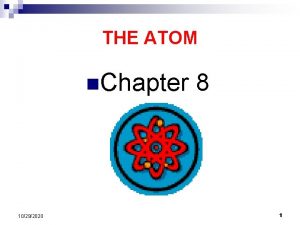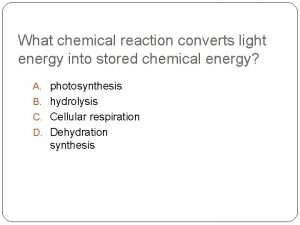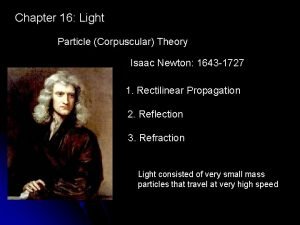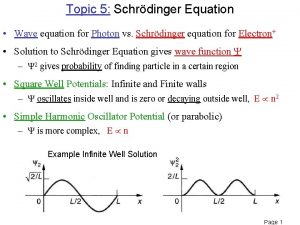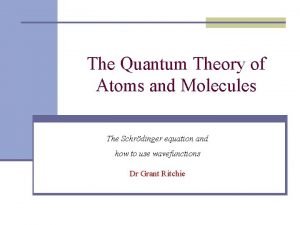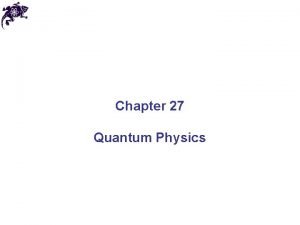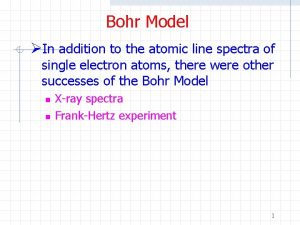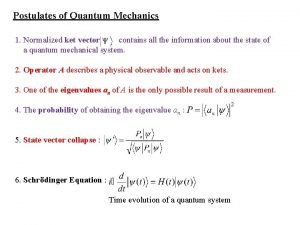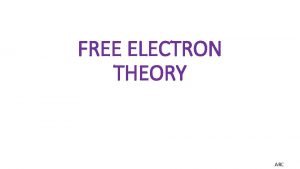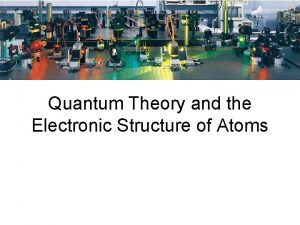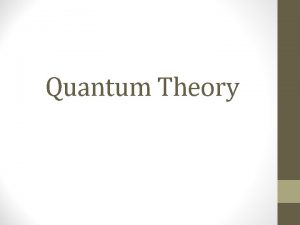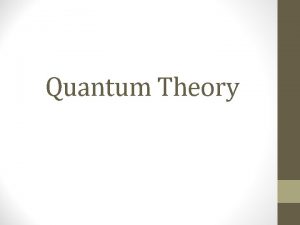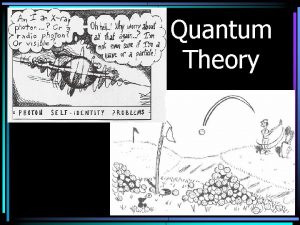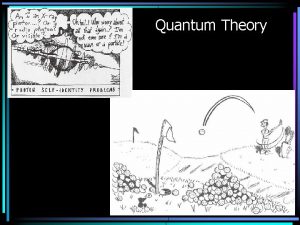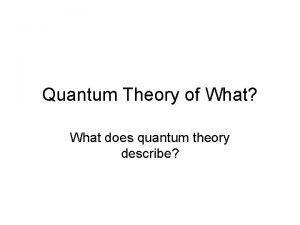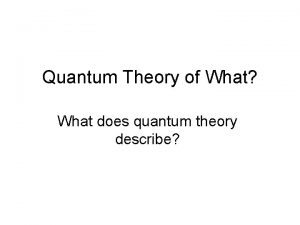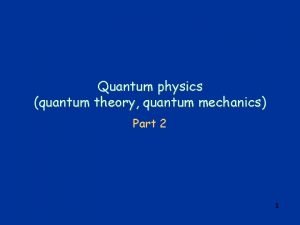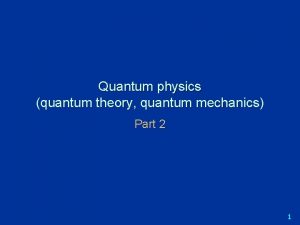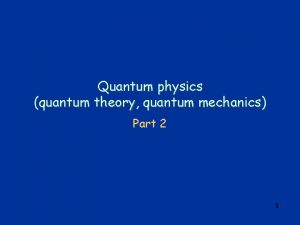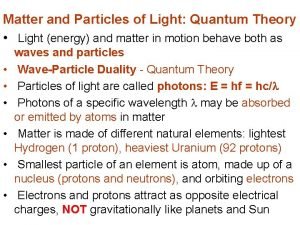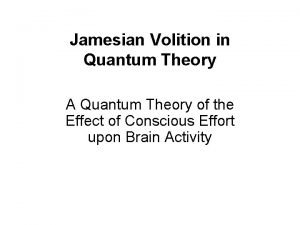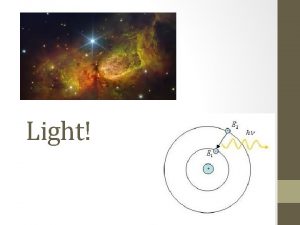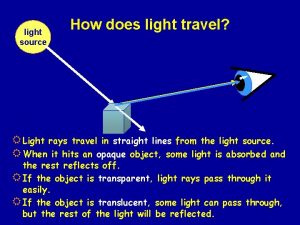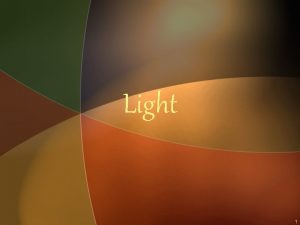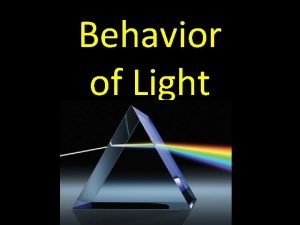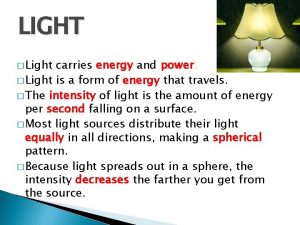Light Quantitized Energy Quantum Theory EQ What does


























- Slides: 26

Light, Quantitized Energy & Quantum Theory EQ: What does the Modern Atom look like? CVHS Chemistry Ch 5. 1 & 5. 2

Problems w/ Rutherford’s model • Didn’t explain: – Where Electrons were – Why Electrons didn’t fall into + charged Nucleus – Chemical Behavior of different elements

Flame Tests

Wave Nature of Light • Amplitude: wave height from origin (vertical center) to crest or trough • Wavelength (λ) – Measured from crest to crest or trough to trough – The wavelength of light is usually expressed in nanometers (1 nm = 1 x 10– 9 m).

Wave Nature of Light • Frequency (n): nu – # of waves that pass a given point per second Hz (/s) • In calculations, frequency is expressed with units of “waves per second, ” or (s– 1) where the term “waves” is understood

Speed of Light (c) • 3. 00 x 108 m/s in a vacuum • Speed of light is the product of it’s frequency and wavelength • What is the wavelength of a microwave having a frequency of 3. 44 x 109 Hz? • Substitute c and the microwave’s frequency, n, into the equation. Note that hertz is equivalent to 1/s or s– 1. • Divide the values to determine wavelength, λ, and cancel units as required.

Plank & The Quantum Concept • matter can gain or lose energy only in small, specific amounts called quanta. – That is, a quantum is the minimum amount of energy that can be gained or lost by an atom.

Photoelectric Effect • In the photoelectric effect, electrons, called photoelectrons, are emitted from a metal’s surface when light of a certain frequency shines on the surface. • Further, Einstein proposed The photon of light must have enough energy to bump the electron off the metal

Atomic Emission Spectra • The atomic emission spectrum of an element is the set of frequencies of the electromagnetic waves emitted by atoms of the element • Each emission spectra is unique, like a fingerprint

Bohr’s Model of the Atom • Since Energy is quantitized (Planck & Einstein) atoms only have 1 allowable energy state – Ground State: Lowest Energy state – Excited State: Energy added above ground state – Energy state is related to location of electron around nucleus • Ground state: Close to nucleus • Excited state: Away from nucleus – Farther away = More Energy

Louis de Broglie’s Atom • Treated electrons orbit as a wave NOTICE: Waves have mass!

Heisenberg Uncertainty Principle • Measuring the location or velocity of an electron changes the location and velocity of the electron • The Heisenberg uncertainty principle Can’t know velocity & position @ same time

Physicist Erwin Schrödinger (1926) & Wave Equations • Treated the electron as a wave – Aka: quantum mechanical model • Seemed to apply to all atoms, not just hydrogen like Bohr’s model • Puts electrons in distinct energy levels but doesn’t describe its path around the nucleus • Atomic Orbital: 3 -D region that describes an electrons most probable location around the nucleus – Sort of a fuzzy cloud – The circle represents the 90% probability area for finding an electron

Quantum Numbers • Principal Quantum Number (n) – Distance from the nucleus – The # of sublevels found in an energy level is equal to the number of the energy level • Energy Sublevels: describe by the shape of the atom’s orbitals – – s, spherical (1) p, peanut or dumbell (3) d, daisy (variable) (5) f, flower (variable) (7)

Energy Levels & Sublevels • Electrons w/in the same energy level but in different sublevels have similar amounts of energy • Sublevels – s, p, d, f – s has the lowest energy & f has the highest energy – Each energy level has the # of sublevels equal to the number of the energy level • Energy level 1 has – 1 s • Energy level 2 has – 2 s & 2 p • Energy level 3 has – 3 s & 3 p & 3 d Look at the shape of each orbital w/in a sublevel. Doesn’t it make sense that it takes more energy for an electron to move in an f pattern than an s pattern?

Electron Configurations • A specific # of electrons can fit into each sublevel • s – Holds 2 electrons • p – Holds 6 electrons • d – Holds 10 electrons • f – Holds 14 electrons

Rules for Electrons • Aufbau Principle: Electrons fill the lowest energy levels first • Hund’s Rule: At any sublevel, electrons go into orbitals one at a time until they have no choice but to pair. • Pauli Exclusion Principle: Any 2 e- in the same orbital must spin in opposite directions.

Electron Configurations • Electrons fill energy levels and sublevels in an orderly fashion w/ the lowest energy orbitals being filled first – This creates the most stable electron configuration • The shape of the modern periodic table is a direct result of the arrangement of electrons in the atom.

Electron Configurations • The periodic table is divided into blocks that show the sublevels and orbitals occupied by the electrons of the atoms. • n represents the energy level and the sublevels are shown as well. • Notice how d and f sublevels have lower energy levels than other atoms in their rows, this is because the pattern that the electrons have to move in is more complex than the s and p sublevels. So an atom will put electrons in a higher energy level s or p sublevel before it puts any electrons in the d sublevel

Blank Periodic table • Take a moment to fill out a blank periodic table

How to write an electron configuration • 1. Find the symbol for the element • 2. Write the symbol in brackets for the nearest smaller noble gas • 3 Write the outer electron configuration for the remaining electrons.

Practice Electron Configurations • • Li Be B C N O F Ne

Periodicity • Elements in same group or family have similar chemical properties • Elements in same period have similar configurations • Periodic table = periodicity: predictable patterns based on electron configurations. Write Noble gas configurations for: Be Mg Ca Sr Ba Ra

Transition Elements • Notice in the periodic table that calcium is followed by a group of ten elements beginning with scandium and ending with zinc – These elements begin to fill the 3 d sublevel • d is very complex so electrons fill 4 s and then 3 d • Metals so they lose electrons and become cations

Inner Transition Elements • Two rows at bottom of periodic table – lanthanides (atomic numbers 58 to 71) – actinides (atomic numbers 90 to 103) • These two series are called inner transition elements because their last electron occupies inner-level 4 f orbitals in the sixth period and the 5 f orbitals in the seventh period

An easy way to remember how atoms fill orbitals & sublevels
 Quantum theory of light
Quantum theory of light Light light light chapter 23
Light light light chapter 23 Into the light chapter 22
Into the light chapter 22 Light light light chapter 22
Light light light chapter 22 Quantum physics vs mechanics
Quantum physics vs mechanics Quantum physics vs quantum mechanics
Quantum physics vs quantum mechanics ________ converts light energy into chemical energy. *
________ converts light energy into chemical energy. * Photosynthesis transforms light energy into chemical energy
Photosynthesis transforms light energy into chemical energy Quantum light experiment
Quantum light experiment Energy energy transfer and general energy analysis
Energy energy transfer and general energy analysis Energy energy transfer and general energy analysis
Energy energy transfer and general energy analysis Expectation value of energy in quantum mechanics
Expectation value of energy in quantum mechanics Expectation value of energy in quantum mechanics
Expectation value of energy in quantum mechanics Black hole teleportation
Black hole teleportation Quantum shannon theory
Quantum shannon theory Chapter 27 quantum theory answers
Chapter 27 quantum theory answers The lowest allowable energy state of an atom is called
The lowest allowable energy state of an atom is called What is the prison program quantum mechanics
What is the prison program quantum mechanics Electrons in atoms section 2 quantum theory and the atom
Electrons in atoms section 2 quantum theory and the atom Moseley law formula
Moseley law formula Postulates of quantum mechanics
Postulates of quantum mechanics What are the drawbacks of classical free electron theory
What are the drawbacks of classical free electron theory Xkcd exponential
Xkcd exponential Quantum theory project
Quantum theory project Quantum theory and the electronic structure of atoms
Quantum theory and the electronic structure of atoms Put out the light then put out the light
Put out the light then put out the light Membrane-bound organelles
Membrane-bound organelles
